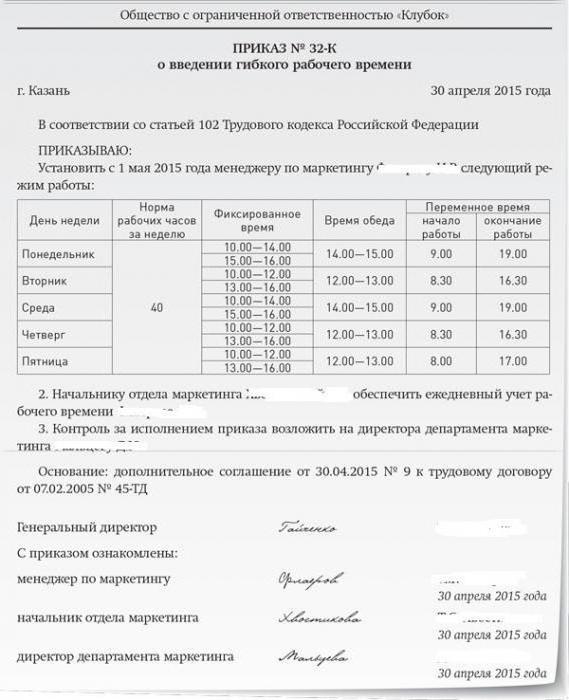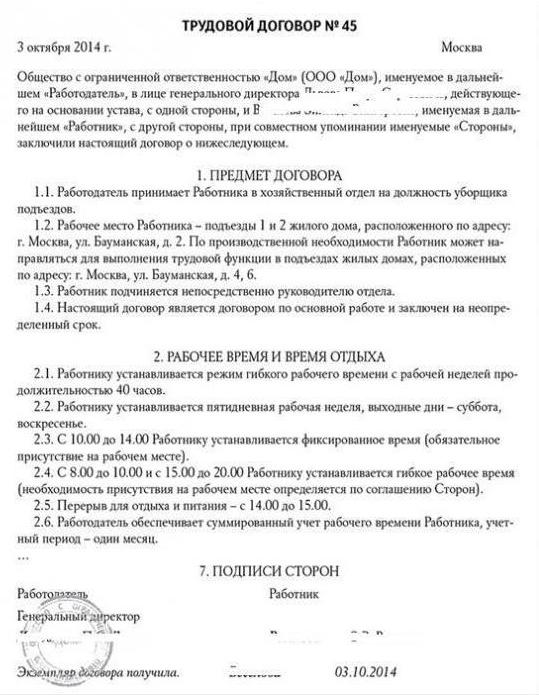Due to certain features, not every organization can work under the established schedule. In connection with this legislation, flexible working hours are provided. In the employment contract, this nuance must be indicated. Consider the main features of a flexible schedule.
Definition
The flexible working time regime implies the organization of working time when individual employees or the team as a whole are allowed to regulate the start, end and total duration of working time within established limits. The specified process is regulated by agreement of the parties.

If the organization has adopted such a regime, then during the accounting period, the set working hours must be worked out in total. The elements of a flexible schedule include:
- variable time (the employee himself regulates the working day within the established time frames);
- fixed time (the employee must be at the workplace at set hours);
- a break (the time allotted for food and rest, which is not included in the general working period);
- accounting period (a certain period during which the hours laid down by law must be worked out).
Flexible working hours in an employment contract should clearly define the type of accounting period. It can be equal to:
- labor day;
- work week;
- working month.
Kinds
Flexible working hours are divided into three types:
- Sliding. An employee who works on such a schedule has a standard time in the labor agreement. It should work, like everyone else, but with floating hours of work. Example: an employee comes to work a few hours earlier than everyone else, but also leaves a few hours earlier.
- Free. The schedule assumes a free visit that is not tied to time. Suitable for people in creative professions.
- Shift Schedule in which the performance of duties is divided into shifts. Good examples are nurses or doctors.
In flexible working hours, the beginning is determined by the terms of the contract or supplementary agreement. And the duration of work is regulated by the schedule of the institution.
Where fixed
Most often, working in flexible working hours is enshrined in the following local documents:
- Rules that govern internal regulations. It reflects: the conditions of employment, the availability of a probationary period, the grounds for dismissal, the conditions for the performance of imputed duties, the regime of work and rest, the grounds for the provision of compensation.
- Collective agreement. This document is intended to establish a list of guarantees for employees, as well as stipulate the terms of cooperation between the parties.
- Contract of employment. A flexible working time regime is mandatory in an employment contract. It is introduced initially, regardless of what the previous schedule was.

If, after hiring a citizen for work, his working conditions, including the mode of activity, will change, this will reflect the additional agreement and the order to change the work schedule.
Limitation
Flexible working hours, contrary to the ability of employees to independently adjust their time, has an important limitation.
There are situations when an employee simply needs to be at the workplace. For example, to attend a meeting or meet with an important customer. For this very reason, a flexible schedule provides for a certain time when the employee must be at his workplace.
What does flexible working hours look like in practice? An example of such a graph is as follows:
| Day of the week | Beginning of work | End of work | Obligatory presence | Lunch break |
| Monday | 8.30 | 15.30 | 9.30 - 11.15 13.30 - 15.00 | 12.00 - 13.00 |
| Tuesday | 9.30 | 16.30 | ||
| Wednesday | 9.30 | 16.30 | ||
| Thursday | 8.30 | 15.30 |
Registration
The introduction of a flexible regime provides not only the establishment of hours of work, but also the written execution of the agreement. Where should it be fixed? The flexible working hours regime in the labor contract should be prescribed as a separate clause, and the registration procedure itself takes place in several stages.
If the initiator is an employee, then he needs to write a statement about changing the work schedule and indicate what hours he can work, indicating the time of the break. Based on this statement, an order is issued. After signing the administrative document, an additional agreement to the main employment contract should be drawn up. It indicates a change in work schedule. The supplementary agreement begins its effect from the moment of its signing.
If the change of schedule is initiated by the employer, then the changes are made according to article 74 of the Labor Code of the Russian Federation. First, the head of the department submits a memorandum to the higher management, where the situation is analyzed and problems are identified, due to which the organization incurs losses. For example, they can occur if employees use their time irrationally. And in order not to overpay for overtime, it is advisable to change the existing work schedule to flexible. Thus, the cost of paying wages will be reduced.
Based on the memorandum, an order is issued. It must be indicated in it that the flexible working hours regime is established in two months for specific employees. What they should be notified in a timely manner.
After two months, another order should be issued, which will approve the list of employees being transferred to the new schedule, the new regime itself and the date on which the document takes effect. After the publication of this order, an additional agreement is signed.
If the flexible schedule is temporary, it is not mandatory. The parties work and interact on the basis of the conditions that are prescribed in the order.
In order to approve flexible working hours, an order, the model of which is proposed below, must be communicated to employees under signature.

Payment
Even if the employee has a flexible schedule, he is still entitled to guaranteed salary payments in the amount established by local acts. But this condition is fulfilled only if the watch norm is established, which is established by law.
According to the labor code, employees are entitled to all benefits, compensation and guarantees. In other words, if the norm is worked out, then the employee must receive a salary. In the case when an employee is involved in work beyond the established time, the employer must guarantee him:
- overtime pay;
- double compensation for the performance of labor duties on weekends;
- reduction of benefits for staff reduction.
As for the vacation, the employee rests his time according to the established schedule of priority.
Flexible working hours in the employment contract provide for the payment of overtime and performance of duties on weekends. This work is regulated by article 99 of the Labor Code. At the same time, payments for the hours worked are made at the end of the accounting period after which they will be counted. So, for the first few hours of processing, payment is no less than one and a half times, for the next hours of processing - at a double tariff.
Also, remuneration for overtime work can be replaced with additional rest time. This fact is negotiated with the employee; the ad-hoc time cannot be more than actually worked out above the norm.

Weekends and holidays, if they are included in the work, are paid according to Article 153 of the Labor Code of the Russian Federation:
- if the payment is made at the daily or hourly rate, the remuneration will be at a double rate;
- if an employee receives a salary, work shall be paid in an amount not less than the daily or hourly rate, provided that it is carried out within the limits of the monthly norm of working time, and in the amount of a double rate if the norm is exceeded.
If the employee wants to take the day off instead of the increased remuneration, the employer must pay for the worked day off or holiday in a single amount, and the rest day should not be paid.
For employees, it is worth saying that the legislation does not establish the time limits when the employer must provide time off instead of payment. Therefore, this fact must be determined by agreement of the parties.
How to keep records
The law provides for the obligation of employers to take into account the actual hours worked by their employees. The main document confirming the fact of labor activity is called the time sheet.
Since the flexible regime of working hours in the labor contract is prescribed as a separate clause and fixes the specific number of hours required for the employee to work, this is exactly the time that should be displayed in the time sheet.
There are two types of accounting:
- Not summarized. This view includes either daily or weekly accounting.
- Summarized.
Daily accounting is applicable when an employee has the same working day every day. Weekly accounting is necessary when an employee works out a different number of hours on different days of the week. But in general, it fulfills the set provisional norm. It equals 40 hours, established by law.
With summarized accounting, the time duration can be different. Deficiency for any day can be compensated by processing in another, but during the accounting period the employee works out the due norm.
All the nuances of the employee should reflect the employment contract. Flexible working hours (sample agreement) can be seen below.

If the accounting is violated, then the authorized person bears the administrative responsibility imposed by the federal labor inspectorate.
Before the work day begins, the employee must mark the start of the shift. And after completion of labor activity - the end of working time. Personnel lists should be publicly available to employees half an hour before and immediately after work begins. The employer or authorized person must ensure control over the accuracy of filling in the personnel list.
If the employee deviated from the established working time, he should be counted as absenteeism.
Who is suitable for
Recommendations for the application of flexible working hours states that they can affect absolutely any position and any organization.
A labor agreement with a rolling schedule can be concluded with a manager, marketer, secretary, etc., the main thing is to understand how such a schedule in a particular position will be appropriate.
For example, a rolling schedule will be convenient for both the employee and the employer, if the former has any other tasks besides work. This includes study or part-time work.

The shift schedule has been known since Soviet times, when the employer needed round-the-clock production, and the performance of labor duties rested on the physiological characteristics of workers. Since a person cannot work all day and 7 days a week, a shift schedule was invented. And the production does not stop, and employees have the opportunity to relax. Today it is widely distributed in factories, in medical institutions, in the fire service, in law enforcement agencies, etc.
The establishment of a flexible working time regime in the form of a free schedule is well used in creative professions. The legal aspect is not violated here - both parties draw up an agreement on the performance of labor duties, and the employer himself does not overpay for the employee for the time that he does not work. Such a schedule may suit artists, designers, musicians, writers.
Of course, there are also such professions where a flexible schedule will be inappropriate. This may include organizations with special security conditions or weak labor discipline. Also, a flexible schedule is not suitable for civil servants due to bureaucratic "slowness."
Nuances
Work in flexible working hours is determined by mutual agreement of two parties, namely: the employee and the employer. But there are categories of workers for whom flexible hours schedule installed initially. The basis for this is federal or industry legislation. The list of works where a flexible schedule should be introduced due to the specifics is indicated in order No. 112 of the RF Ministry of Communications.
A regulatory document has also been established for women in position or with small children. And since it operates to this day, it can be guided by both the employee and the employer.

The use of flexible schedules should provide women with the optimal combination of economic, social and personal aspects. According to the law, such a regime can be established both indefinitely and for a certain period. For example, during the school year or until the child reaches a specific age (16 years of age or majority).
Advantages and disadvantages
Each work schedule has both positive and negative sides. Therefore, choosing a particular schedule, the leader and employee should focus on identifying possible benefits.
Consider the pros and cons of a flexible schedule for employees. The positive aspects include:
- the possibility of combining work with other activities;
- personal regulation of the amount of work performed, which prevents overloads;
- the reality of combining work and family obligations (relevant for mothers with young children).
Among the negative points should be highlighted:
- difficulties in fulfilling labor obligations, if there is a need to interact with other employees working in a similar schedule;
- the lack of constant monitoring leads to the postponement of important cases for an indefinite period;
- lack of career growth.
From the above it follows: if the employee is responsible and knows how to organize his work, then this schedule is most preferable. Otherwise, it is better to look for a job with a permanent schedule.
For the employer, flexible working hours also bring pros and cons. Positive sides:
- increasing the degree of responsibility among employees due to the lack of constant control by the bosses, as well as increasing the efficiency of the work process and trust in the leader;
- the absence of problematic situations with labor discipline due to blurring the boundaries of working time (for example, a free visit does not determine a clear time for the implementation of the work process);
- attracting high-profile specialists to the workflow because of the convenience of this type of schedule.
The negative points include the following:
- such a schedule is not suitable for managerial positions due to the fact that the boss must be at the workplace full time to be able to solve production issues and control the work process as a whole;
- the presence of difficulties in monitoring the unconditionalness of the hours worked and the execution of the established amount of work, as well as monitoring the quality of the execution of assigned tasks;
- increase in costs while providing employees of the organization with means of communication and accounting for hours worked.
In general, the manager can benefit from the establishment of a flexible working regime, as employees will no longer think about early hikes, think about lateness, and will be able to focus on the result. But a lack of control by the management can lead to a decrease in labor productivity and the quality of work performed.